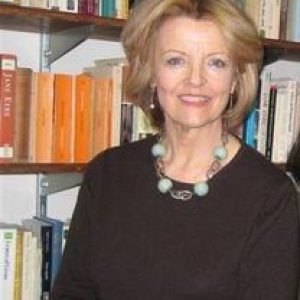
Author, broadcaster, film-maker, art critic and conservationist, Polly Devlin has had a remarkable career, taking her far from her rural roots in County Tyrone to the sophisticated world of Vogue in London, New York and Paris.
POLLY DEVLIN was born in a remote almost medieval area in Northern Ireland in the 1940's. There were no telephones or electricity in the region when she was growing up. Although most people travelled by pony and trap, there were two motor cars — one was her father's, the other belonged to the local priest.
Her first job was as a result of having won the Vogue Talent competition, the main attraction of which was a job on the magazine. She was twenty years old and she says the question she most often has to answer is how someone from so different and rural a background could have gone straight into life at Vogue. As Features Editor in the 1960's, she travelled the world interviewing people as disparate as Farah Diba - the Empress of Persia, to Barbra Streisand, Orson Welles, John Lennon, Janis Joplin, John Osborne, Andy Warhol. She was the first person to interview Bob Dylan in England, to write about Seamus Heaney, and almost certainly the first woman to travel across Abu Dhabi, which she did before that country became oil-rich. She recalls seeing horses being turned off a patch of hardened earth as the tiny aeroplane which brought her to Abu Dhabi came in to land; as one recalcitrant horse galloped in front of the aeroplane she realised that their paddock was also the landing strip.
Polly worked with photographers including David Bailey, Norman Parkinson, Richard Avedon, Irving Penn, Terry Donovan and Lord Snowdon.
She became a columnist for the New Statesman when she was twenty-three, and had her own page in the Evening Standard a year later. Soon after, she went to live in Manhattan as a Features Editor and writer for Diana Vreeland on American Vogue covering international stories, theatre and the arts.
Polly married industrialist Adrian Garnett in Tuscany and moved to Somerset in England.
She published her first two books in 1983— All of Us There and The Far Side of the Lough — on the same day, without reference to each other, by different publishers, Weidenfeld & Nicholson and Victor Gollancz. They have remained in print since then and have gone into several editions. All of Us There is now a Modern Classic in the Virago imprint.
For four years during the 1980's, she took a director's course at the National Film School in England and wrote and directed the documentary The Daisy Chain.
In 1990, she became a roving critic, with particular emphasis on art and major exhibitions for The International Herald Tribune for a year and wrote a publication for the National Gallery of Ireland on their ceramic collections.
In 1991, she bought a house in Dublin and finding she knew little about the city, set about finding out more. The result was Dublin - a comprehensive guide book to the city.
In 1993, she was awarded an OBE for services to Literature.
Her interest in photography led her to write the foreword to the large retrospective of British photography - A Positive View - at the Saatchi gallery in London in 1994.
She hosted a series of talks and interviews on television for BBC Northern Ireland, has broadcast many talks and short stories and has written a radio play for the BBC in London.
Stories from The Far Side of the Lough are frequently broadcast. She is on the Northern Ireland team in the Round Britain Quiz on Radio 4.
Polly became interested in conservation and planted thousands of trees, reclaimed hundreds of acres for wild flower restoration, bird reserves and lakes around her home in Somerset. Cannwood Meadow, now a Site of Special Scientific Interest has featured in many television programmes. andis the subject of a book.
She has been a Judge of the Booker Prize in England and a judge on the Irish Times Aer Lingus Literary award.
Polly is a professor at Barnard College, Columbia University, New York, where she teaches Creative Non- Fiction.
She lives in Paris and London and is finishing a book about Ireland in the 16th century.
In addition to her three acclaimed books, All Of Us There, The Far Side of the Lough and Dora: or The Shifts of the Heart (Chatto & Windus: London), she is the author of the Vogue Book of Fashion Photography, (Thames and Hudson: London, Simon and Schuster: New York, 1979) which has also been published in Italian, German and French). Other books include Dublin: A Guide Book (Mitchell Beazley: London 1996) a volume of essays, Only Sometimes Looking Sideways (O'Brien Press: Dublin, 1988) and A Year in the Life of an English Meadow (Francis Lincoln: London, 2007).(
A SENSE OF PLACE: Do those who have a strong sense of place have it because they've lost it? Is a sense of place a sense of yearning? There's a real difference between a sense of place and of going home or of being 'at home'. In a way, by having a sense of place you've already left it. So can only dislocated people have a real sense of place, that place being, paradoxically the place you've lost? What is true is that a writer must be able to convey a sense of place if he or she is to be a writer. You have to know where you are: but more importantly where you have been. And it is this place of 'been' that informs and colours so many writers. One of these places is childhood.
Polly Devlin, February 2012